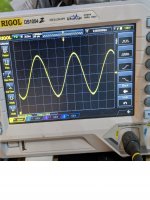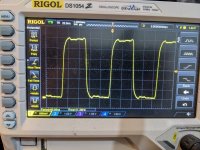I am not sure you can find a sine waveform clock signal anywhere in a cd player. At which pin of the SAA7220 did you measure it?
You probably can at the input pin of the crystal oscillator, as the signal there has been filtered by the crystal.
I measured it at X-in Cant remember pin. The sine wave was original clock signal. Another identical cd player had the clock mod and that was the result with square wave. I didnt have the capabilities to test them to see if they had a difference but I was very intrugued by it and wanted to understand more.
Almost all CD players have some sort of crystal oscillator as a clock source. The crystal oscillator consists of a quartz crystal, a circuit that makes it oscillate and a slicer. The waveform of the signal coming out of the crystal is always nearly sinusoidal, the slicer converts it to a square wave that drives the rest of the CD player.
In a CD player with an SAA7220, normally everything but the quartz crystal is on the SAA7220 chip, see figure 13 of https://pdf1.alldatasheet.com/datasheet-pdf/view/19042/PHILIPS/SAA7220.html
Your clock modification probably entails connecting an external crystal oscillator rather than just a crystal to the SAA7220. The sine wave then occurs somewhere inside the external oscillator circuit and the square wave at its slicer output drives the SAA7220. The steeper edges reduce the jitter that the SAA7220 adds to the clock signal, but instead you now get the jitter of the slicer inside the external oscillator. If the external oscillator has better performance than the one inside the SAA7220, you can still have a better clock than with the standard circuit. Whether the difference is worth the effort is a different discussion.
In a CD player with an SAA7220, normally everything but the quartz crystal is on the SAA7220 chip, see figure 13 of https://pdf1.alldatasheet.com/datasheet-pdf/view/19042/PHILIPS/SAA7220.html
Your clock modification probably entails connecting an external crystal oscillator rather than just a crystal to the SAA7220. The sine wave then occurs somewhere inside the external oscillator circuit and the square wave at its slicer output drives the SAA7220. The steeper edges reduce the jitter that the SAA7220 adds to the clock signal, but instead you now get the jitter of the slicer inside the external oscillator. If the external oscillator has better performance than the one inside the SAA7220, you can still have a better clock than with the standard circuit. Whether the difference is worth the effort is a different discussion.
I took both measurements at the exact same pin. I tried to listen as much as I could to see the difference as I have always wanted to do a clock mod myself. Because I had the players at different times it was hard to compare, sound quality wise.
To confirm technically the square wave is better?
To confirm technically the square wave is better?
I took both measurements at the exact same pin.
That's also how I interpreted it. The point is that in the case with the square wave at the SAA7220 XIN input, there will still be a sine wave that gets generated and then converted into a square wave somewhere in the CD player, it just won't be done by the SAA7220, but by some other circuit.
To confirm technically the square wave is better?
Rent or borrow a very good spectrum analyser, phase noise measurement system or jitter analyser and measure the jitter or the phase noise at pins 9 and 18 of the SAA7220, that is, of the clocks going to the TDA1541. The measuring equipment will usually have a 50 ohm input, so you may need a resistive voltage divider or an active probe to prevent overloading the SAA7220. You don't stand a chance with a normal oscilloscope.
Correction: according to figure 9 of the SAA7220 datasheet, its crystal oscillator also requires two external capacitors and an external resistor.In a CD player with an SAA7220, normally everything but the quartz crystal is on the SAA7220 chip, see figure 13 of https://pdf1.alldatasheet.com/datasheet-pdf/view/19042/PHILIPS/SAA7220.html
- Home
- Source & Line
- Digital Source
- Understanding waves clock CD player

